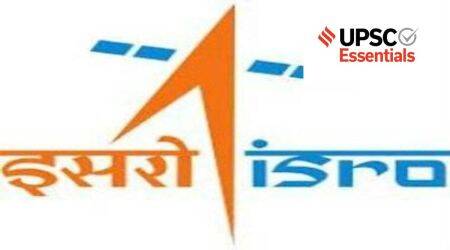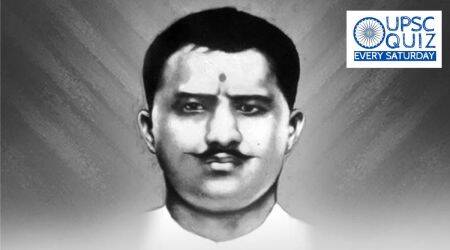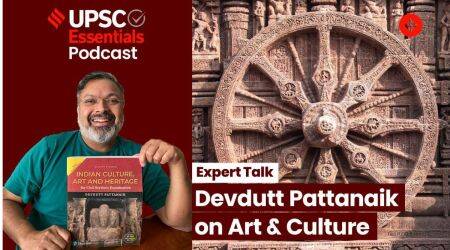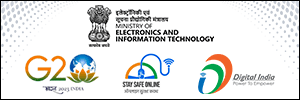UPSC Key-19 June, 2023: What you should read in the news today
Exclusive for Subscribers from Monday to Friday: Have you ever thought that why Gita Press or Cross-staffing postings and many more are relevant to the UPSC Exam? What significance do topics like Rozgaar Mela or Pride flag have for both the preliminary and main exams? You can learn more by reading the Indian Express UPSC Key for June 19, 2023.
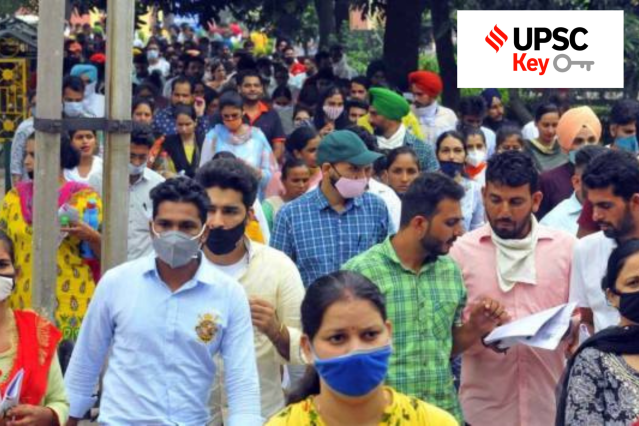 UPSC Key June 2023: Here's what you should be reading from the June 19, 2023 edition of The Indian Express
UPSC Key June 2023: Here's what you should be reading from the June 19, 2023 edition of The Indian Express Important topics and their relevance in UPSC CSE exam for June 19, 2023. If you missed the June 16, 2023 UPSC key from the Indian Express, read it here
FRONT PAGE
Senior officers to be posted across services as part of integration move
Syllabus:
Preliminary Examination: Current events of national and international importance
Mains Examination: General Studies III: Various Security forces and agencies and their mandate.
Key Points to Ponder:
• What’s the ongoing story- For the first time, the Indian Armed Forces are planning to go ahead with cross-services postings of a large number of senior officers in the ranks of Brigadier and Major General and equivalent shortly. This will be in line with efforts towards tri-service integration and the planned creation of theatre commands, senior officials familiar with the development told The Indian Express. This comes days after inter-service postings of a large batch of around 40 officers of the rank of Major and Lieutenant Colonel and equivalent, again a first, were announced. Earlier, only a handful of such postings had taken place within the services.
• Why cross-staffing postings?
• Do You Know- The cross-postings are in line with plans to integrate the three services and create theatre commands. There are plans to create two adversary-based theatre commands — one facing Pakistan and the other for China — and a third command to tackle threats in the maritime domain, from the 17 service-specific military commands currently operating under the three services.
• “Cross-staffing postings can be significant step in creating cross functional teams which will be a primary requirement for achieving theaterisation”-Comment
• Cross-staffing postings-Know its pros and cons
• For Your Information-The officers would be transferred to missile units, for handling UAVs and for logistics, repair and recovery and material and supplies management among other roles in the two other services. There are several common equipment, weapon systems and platforms across the services and the cross staffing of officers will help each other understand the service they are posted in, better, thus paving way for greater synergy and integration among them.
• What do you understand by annual confidential reports?
• The Indian Armed Forces have decided to go for common annual confidential reports-Why?
• What is theaterisation of Armed Forces?
• Integrated Theatre Commands of the Indian Armed Forces-Know in detail
• Kargil Review Committee on theaterisation of Armed Forces -What was there in the report?
• What are Theatre Commands?
• What work has been done on Theatre commands?
• Chiefs of Staff Committee (COSC)-Role and Importance
• Chiefs of Staff Committee (COSC) and Chief of Defence Staff-Compare and Contrast
• Why did the Government of India amend the Army Rules, 1954, the Naval Ceremonial, Conditions of Service and Miscellaneous Regulations, 1963, and the Air Force Regulations, 1964?
• What will be the upcoming Issues and Challenges for the recent amended service rules of the armed forces?
Other Important Articles Covering the same topic:
📍Cross staffing of Army officers to IAF, Navy soon
📍Soon, common confidential reports for senior officers in Armed Forces
GOVT & POLITICS
Gandhi Peace Prize 2021 for Gita Press, PM, UP CM hail its contribution
Syllabus:
Preliminary Examination: History of India and Indian National Movement
Main Examination: General Studies I: Modern Indian history from about the middle of the eighteenth century until the present significant events, personalities, issues.
Key Points to Ponder:
• What’s the ongoing story– Gita Press, Gorakhpur, has been selected for the Gandhi Peace Prize for the year 2021. A jury headed by Prime Minister Narendra Modi unanimously selected Gita Press for the award after due deliberations on Sunday “in recognition of its outstanding contribution towards social, economic and political transformation through non-violent and other Gandhian methods,” the government said in a statement. Last year, the prize was conferred on former Bangladesh president Sheikh Mujibur Rahman.
• Gita Press-Know in brief
• Gita Press was founded by whom?
• Do You Know-The founder of Gita Press was Marwari businessman Jayadayal Goyandka from Churu in Rajasthan who was based in Bankura, Bengal, and used to trade in cotton, kerosene oil, textiles, and utensils. An avid reader of the Bhagavad Gita, he formed groups of friends in the towns where he used to travel for business and these men joined him in religious congregations, called satsangs, to discuss the book. This network of Gita discussion groups expanded but all of the satsangis realised that they did not have an authentic, error-free translation of the Gita along with a faithful commentary. In 1922, Goyandka got the Gita published by Vanik Press in Kolkata but errors prevailed. When Goyandka raised the matter with the press owner, he got told off. The press owner told him to set up his own press if he wished to see an error-free translation of the book. Thus began the journey of Gita Press.
• Role of Press in India’s struggle for freedom-Analyse
• Gandhi Peace Prize-Know in detail
• The Government of India launched the International Gandhi Peace Prize in which year?
• Jury for Gandhi peace prize-who are in the Jury?
Other Important Articles Covering the same topic:
📍A century old, how Gita Press came to be ‘leading purveyor of print Hinduism’
📍Gita Press to receive Gandhi Peace Prize: A brief history of the publishing house
Over 4 lakhs hired by Govt under ‘Mission Recruitment’ so far —every sixth a woman
Syllabus:
Preliminary Examination: Indian Polity and Governance-Constitution, Political System, Panchayati Raj, Public Policy, Rights Issues, etc.
Main Examination: General Studies II: Government policies and interventions for development in various sectors and issues arising out of their design and implementation.
Key Points to Ponder:
• What’s the ongoing story-Around one in every six candidates hired so far under ‘Mission Recruitment’, the Government’s bulk recruitment drive to fill 10 lakh posts by 2023 end, were women, official data shows. Hired as clerks and typists, teachers and doctors, at least 4,30,546 candidates were handed their appointment orders during six Rozgar Melas organised by the Government. Of these, 3,61,763 (84%) recruits were male and 68,783 (16%) women, shows data available with the Ministry of Personnel, Public Grievances and Pensions.
• What is Rozgaar Mela?
• What is the purpose of Rojgar Mela?
• Who organises Rozgar Melas across the nation?
• Rozgar Mela- What are the Key takeaways?
• What is Karamyogi Prarambh Module?
• For Your Information- According to the Ministry of Skill Development And Entrepreneurship’s official website, Rozgaar mela is to give impetus to the employment initiatives in the country, National Skill Development Corporation (NSDC) under the aegis of Ministry of Skill Development & Entrepreneurship (MSDE), Govt. of India has been organizing Rozgar Melas across the nation for providing suitable job opportunities in private sector to the unemployed youth. With initiatives like Rozgar Melas, the Government is ensuring a parallel growth in the private/ industrial sector. There is no end to the potential for industry to flourish across the States with big corporates partnering the government and pledging to invest. A NSDC Rozgar Mela is a 1/2-day event where several employers and job seekers come together for the purpose of applying and interviewing for jobs. Defined more precisely, a Rozgar Mela is an employment strategy to fast-track the meeting of job seekers and employers. For the execution of Rozgar Melas, NSDC seeks support from the respective Sector Skill Councils (SSCs) & Pradhan Mantri Kaushal Kendras (PMKKs) for sourcing the employers i.e. private companies for the Rozgar Mela. Generally, a Rozgar Mela witnesses the participation on an average of 40-50 employers from 10-12 high economic growth sectors. These sectors are generally identified based on the aspiration of youth & availability of industries in the target State or the nearby areas.
Other Important Articles Covering the same topic:
📍About Rozgar Mela
Collegium system transparent, better than NJAC: Justice Dhanuka
Syllabus:
Preliminary Examination: Indian Polity and Governance
Main Examination: General Studies II: Structure, organization and functioning of the Executive and the Judiciary
Key Points to Ponder:
• What’s the ongoing story– Justice Ramesh Deokinandan Dhanuka, who retired as Chief Justice of the Bombay High Court on May 30, said the present Collegium system for appointment of judges is better than the National Judicial Appointments Commission (NJAC) and continuation of the same will help in ensuring independence of judiciary. Justice Dhanuka, who served as a HC judge for over 11 years and practiced as a lawyer for nearly 27 years, added that there should not be any confrontation between judiciary and the executive in public and the issues should be sorted behind closed door meetings.
• First of all, what is your understanding about the collegium system?
• What is the issue of conflict between Judiciary and Executive with respect to the appointment of Judges?
• Executive Vs Judiciary for appointment of judges in higher judiciary-Know in detail
• What is the sanctioned strength of Supreme Court Judges in India?
• Who appoints the Judges of the Supreme Court?
• What does the Collegium consider while making the recommendation?
• National Judicial Appointments Commission (NJAC) Act 2014-Know the key highlights
• Supreme Court on NJAC Act 2014 (99th Constitutional Amendment Act)-know in detail
• First Judges Case (1982), Second Judges Case (1993) and Third Judges Case (1998)-Know in detail
• What was the Supreme court’s ruling in the Second Judges case (1993), with respect to the appointment of a judge?
• Third Judges case (1998) and Supreme Court’s ruling in case of the appointment-What was the Supreme Court’s ruling?
• The National Judicial Appointments Commission Act of 2014 and the Collegium System-Compare and Contrast
• The Constitution has made certain provisions to safeguard and ensure the independent and impartial functioning of a Judges-Know in detail
Other Important Articles Covering the same topic:
📍Collegium system is better than the NJAC
THE EDITORIAL PAGE
Syllabus:
Preliminary Examination: Current events of national and international importance.
Mains Examination:
• General Studies II: Functions and responsibilities of the Union and the States, issues and challenges pertaining to the federal structure, devolution of powers and finances up to local levels and challenges therein.
• General Studies III: Linkages between development and spread of extremism and Role of external state and non-state actors in creating challenges to internal security
• General Studies III: Role of external state and non-state actors in creating challenges to internal security.
Key Points to Ponder:
• What’s the ongoing story- Kham Khan Suan Hausing Writes: The grisly violence that continues unabated in Manipur since May 3 has generated widespread concern and animated debates. Taking a cue from Paul Brass, I maintained in my last article (‘Fault lines in Imphal’, IE, May 5) that Manipur’s violence follows an established pattern of “institutionalised riot system” (IRS) witnessed earlier in other parts of India. Although various explanations are offered from disparate quarters, IRS remains the major and constant source of structural violence in the state. If the deafening silence of Prime Minister Narendra Modi and unheeded appeal of Home Minister Amit Shah for a 15-day peace after his visit to Manipur on May 29 are any guide, structural violence that stems from this system shows no sign of immediate closure.
• What have you understood by “institutionalised riot system”?
• Manipur’s violence follows an established pattern of “institutionalised riot system”-Comment
• Quick Recall-Violent clashes broke out at various places in Manipur during the course of a ‘Tribal Solidarity March’ called on Wednesday (May 3) by the All Tribal Students’ Union of Manipur (ATSUM).
• What is the present status?
• Why still people are protesting?
• What stand or measures Government of India has taken so far to tackle with this situation?
• Why is violence still continuing in Manipur?
• “A major source of structural violence remains the lack of political will to fix accountability with Chief Minister Biren Singh who continues to preside over the complete breakdown of law and order”-Comment on the state machinery’s failure to tackle the violence in Manipur
• What is B P Jeevan Reddy Committee associated with?
• How many different ethnic groups are there in Manipur?
• What exactly triggered the violence in the state?
• Who are Kuki and Meitei?
• Which are the major communities residing in Manipur?
• The Kuki-Zomi insurgent groups-Know in detail
• “The insurgent groups are intricately woven into the daily life in Manipur”-Comment
• Map Work-Manipur and adjoining areas
• Manipur has been in the cross-currents of India’s oldest insurgent movements-why?
• History of conflict in Manipur-Know in detail
Other Important Articles Covering the same topic:
📍Manipur riots: The chilling methods in the madness
EXPRESS NETWORK
Shift in militant strategy: Why Jammu is seeing a terror thrust
Syllabus:
Preliminary Examination: Current events of national and international importance.
Mains Examination: General Studies III: Security challenges and their management in border areas – linkages of organized crime with terrorism.
Key Points to Ponder:
• What’s the ongoing story-Two attacks on security personnel in the space of a fortnight — on April 20, when five soldiers were killed as militants ambushed their truck in Poonch; and on May 5, when five Army personnel were killed in an explosion in a forested area in Rajouri — have suddenly made Jammu, a region that was largely seen as more peaceful of the two regions of J&K, the focus of a new terror thrust.
• Map Work-Poonch, Rajouri and Jammu
• What separates Jammu region from the Kashmir Valley?
• Map Work-Pir Panjal Range, East, North, South and West of the Pir Panjal
• Despite the numbers pointing to more terror attacks and casualties in the Valley than in the Jammu region, the security establishment has taken note of a changing trend-What changing trend?
• Why this change is happening?
• For Your Information-“Fewer but high-impact incidents, especially involving casualties of security personnel and civilians, give the terrorists the publicity they seek,” said an official in the security establishment, adding, “The areas to the south of the Pir Panjal range can be accessed through easier and all-weather infiltration routes. However, since the terrorists lack adequate logistics support in this region, the ones who are eventually chosen to infiltrate here are more hardened and target security forces and civilians.” The attacks in Jammu tend to have a higher impact, the official said, because of the “routine nature of small-scale incidents in the Valley… As a result, at times, even fairly bigger incidents (in the Valley) fail to capture public attention which they would have if they had taken place to the south of the Pir Panjal”.
• Who are called militants?
• What is terrorism in Indian law?
• Militant and Terrorist-What are the differences?
• What are the types of terrorism?
• What are the reason for terrorism especially in the Jammu and Kashmir?
• What are the components of terrorism?
Other Important Articles Covering the same topic:
📍J&K terror shift: Valley dominates count but bigger strikes in Jammu
EXPLAINED
New flag: Why the most visible Pride symbol was updated
Syllabus:
Preliminary Examination: Current events of national and international importance.
Main Examination: General Studies I: Social empowerment
Key Points to Ponder:
• What’s the ongoing story– The month of June, recognised worldwide as the Pride Month, is marked by many events across India to celebrate the LGBTQIA+ community. And you might have noticed that most of these events are marked by a flag — a simple red-to-violet rainbow, and in some cases, the more updated version of it, which is known as the Intersex-Inclusive Progress Pride Flag, created by Valentino Vecchietti of Intersex Equality Rights UK in 2021. This is actually a new version of the previous Progress Pride Flag created in 2018 by Daniel Quasar. While most organisations in India still use the older rainbow pride flag in their events, the new variation of it is being increasingly accepted as a more inclusive representation for the community.
• What LGBTQIA+ stands for?
• What’s Pride flag?
• Do You Know-A Pride flag essentially represents the pride associated with LGTQIA+ social movements. For centuries people belonging to the community have had to fight for basic rights in countries across the world. The struggle continues in many countries. Uganda, for instance, recently passed a law criminalising the LGBTQIA+ community.
In India too, gay sex was decriminalised as recently as 2018. The Pride flag was used by activists, members of the community and allies as a symbol of resistance and acceptance. It was designed by renowned American artist and activist Gilbert Baker.
• What is the history of the pride flag?
• Why is it called Intersex-Inclusive Progress Pride Flag?
• What is Section 377 of IPC?
• What is sexual orientation discrimination?
• What is an example of sexual orientation harassment?
• What percentage of Indian population is LGBTQIA+?
• Do you Know-India’s 2011 Census was the first census in its history to incorporate the number of ‘trans’ population of the country. According to the 2011 Census, the number of persons who do not identify as ‘male’ or ‘female’ but as ‘other’ stands at 4,87,803 (0.04% of the total population). This ‘other’ category applied to persons who did not identify as either male or female, and included transgender persons.
• “Sex is biologically determined but gender is a social construct”-Critically Analyse
• What are the Yogyakarta Principles?
• Know some landmark Judgements by the Supreme Court of India Contributing to LGBTQ Rights
• What was the Supreme Court’s verdict in National Legal Services Authority vs Union Of India, 2014?
• Decriminalisation of homosexuality was much needed for transgenders and Section 377-Connect the dots
Other Important Articles Covering the same topic:
📍The new Pride flag: Why the change, what the colours signify
📍The 360° UPSC Debate: Same-Sex Marriage in India – Urban Elite Concept Or Integral Right?
Syllabus:
Preliminary Examination: General issues on Environmental ecology, Bio-diversity and Climate Change
Mains Examination: General Studies III: Conservation, environmental pollution and degradation, environmental impact assessment.
Key Points to Ponder:
• What’s the ongoing story– Prime Minister Narendra Modi during his latest ‘Mann ki baat’ episode spoke about Miyawaki plantation, the Japanese method of creating dense urban forests in a small area. The PM also cited the example of a Kerala-based teacher, Raafi Ramnath, who used the Miyawaki technique to transform a barren land into a mini forest called Vidyavanam by planting 115 varieties of trees. Meanwhile, to fight climate change, curb pollution levels, and increase the green cover of the financial capital, the Brihanmumbai Municipal Corporation (BMC) has been creating Miyawaki forests in several open land parcels of Mumbai.
• What is the Miyawaki plantation method?
• How is Miyawaki useful?
• Which other areas in Mumbai have such forests?
• What do you understand by ‘urban farming’?
• What are the different types of Urban Farming?
• What are the benefits of urban farming?
• What are the challenges associated with Urban farming?
• Urban land-use planning (ULP) and urban farming-Connect the dots
Other Important Articles Covering the same topic:
📍Urban agriculture can help make cities sustainable and liveable
What’s in a name change? The right to life under Art 21, say 2 High Courts
Syllabus:
Preliminary Examination: Indian Polity and Governance-Constitution, Political System, Panchayati Raj, Public Policy, Rights Issues, etc.
Main Examination: General Studies II: Indian Constitution—historical underpinnings, evolution, features, amendments, significant provisions and basic structure.
Key Points to Ponder:
• What’s the ongoing story– The right to change one’s name or surname is a part of the right to life under Article 21, the High Courts of Allahabad and Delhi recently said. Allowing a man called Shahnawaz to change his name to Md. Sameer Rao, the Allahabad HC on May 25 said the fundamental right to keep or change one’s name is vested in every citizen under Articles 19(1)(a), 21, and 14 of the Constitution. The Delhi HC on May 19 allowed a plea filed by two brothers to reflect their father’s changed surname — from “Mochi” to “Nayak” — on their Class 10 and 12 Board certificates, stating that the right to identity is an “intrinsic part” of the right to life under Article 21.
• Why did the petitioners want to change their names?
• Why were their name-change requests denied by the authorities?
• What did the Allahabad HC hold?
• What did the Delhi HC hold?
• What did the courts say about Article 21?
• What are some restrictions on the right to change names?
• What is Article 21in the Constitution of India?
Other Important Articles Covering the same topic:
📍‘Natural Justice’ and ‘Proportionality’: Why Supreme Court ruled in Media One’s favour
For any queries and feedback, contact priya.shukla@indianexpress.com
The Indian Express UPSC Hub is now on Telegram. Click here to join our channel and stay updated with the latest Updates.



